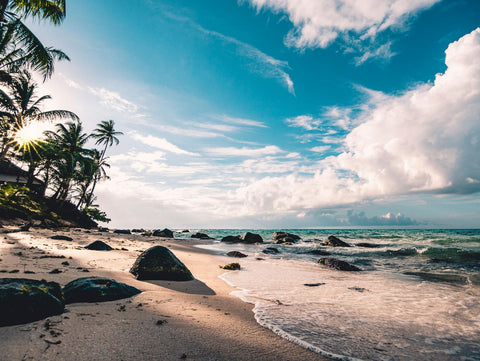Enhance Your Surfing with Wave Pattern Reading
Prepare to ride the waves like never before as we dive into the captivating world of wave pattern reading. Imagine being able to predict the perfect wave, anticipate its every move, and carve through the water with unmatched precision. That's the power of wave pattern reading – a skill that separates the average surfer from the true wave whisperers.
In this article, we'll explore how mastering the art of wave pattern reading can revolutionize your surfing experience and unlock a whole new realm of possibilities. From understanding the intricacies of wave behavior to positioning yourself strategically in the lineup, we'll cover everything you need to know to become a wave-riding virtuoso.
So, whether you're a seasoned shredder or a wave-riding novice, get ready to embark on an exhilarating journey of discovery as we delve into the fascinating world of wave pattern reading. Get ready to enhance your surfing, elevate your skills, and experience the ocean in a whole new light. The waves are calling – are you ready to answer?

The Basics: What Are Wave Patterns?
The rhythmic heartbeat of the ocean–wave patterns is the mesmerizing symphony that beckons surfing enthusiasts to its shores. But what exactly are these mystical undulations that captivate our senses?
In essence, wave patterns are the result of energy transfer through water, often driven by wind, tides, and other natural forces. Picture this: as the wind whips across the surface of the ocean, it imparts its energy to the water, creating a ripple effect that travels across vast distances.
These ripples, or waves, come in all shapes and sizes, from gentle swells to towering giants. For surfing aficionados, understanding the nuances of wave patterns is essential for catching the perfect ride. It's about reading the subtle cues of the ocean – the way waves rise and fall, the way they break and reform – and harnessing that energy to glide effortlessly across the water.
So, the next time you're out on the waves, take a moment to appreciate the beauty and complexity of wave patterns – and let them carry you on an unforgettable surfing adventure.
Factors Influencing Wave Patterns: Tides, Swell Direction, Wind, and More
When it comes to understanding wave patterns, it's essential to recognize the multitude of factors at play. From the gentle ebb and flow of the tides to the powerful forces of wind and swell direction, each element contributes to the complex dance of the waves.
Let's start with tides – the rise and fall of the ocean caused by the gravitational pull of the moon and sun. Tides play a significant role in shaping wave patterns, with incoming tides often bringing larger waves and outgoing tides creating smaller, more manageable surf.
Next up is swell direction – the angle from which waves approach the coastline. Swell direction can vary depending on factors such as storm activity, wind patterns, and geographical features. Surfers must pay close attention to swell direction to determine the quality and consistency of waves at their local break.
Then there's the wind – a powerful force that can either enhance or diminish wave quality. Offshore winds, which blow from land to sea, create clean, well-defined waves ideal for surfing. Onshore winds, on the other hand, can wreak havoc on the waves, causing them to break prematurely and lose their shape.
But the influence of wind doesn't stop there – it also plays a role in creating wave chop, which can make for challenging surfing conditions. Other factors, such as underwater topography, coastal features, and even human activity, can also affect wave patterns in subtle yet significant ways.

Identifying Different Types of Waves: From Point Breaks to Beach Breaks
Not all waves are created equal. From the glassy perfection of point breaks to the playful chaos of beach breaks, each type of wave offers its own unique challenges and rewards.
Let's start with point breaks – these waves break along a rocky or sandy point of land, creating long, peeling waves that are perfect for carving and maneuvering. Surfing a point break requires patience and precision, as riders must navigate the wave's curved path and anticipate its every move.
On the other hand, beach breaks are known for their unpredictable nature, with waves breaking over sandy bottoms and shifting sandbars. Surfing a beach break requires adaptability and quick reflexes, as riders must constantly adjust to changing conditions and shifting peaks.
Whether you prefer the long, smooth rides of a point break at Rincon or the fast, punchy waves of a beach break at Chame Banks, identifying different types of waves is essential for maximizing your surfing experience. So, next time you paddle out, take a moment to assess the waves around you – and get ready for an unforgettable ride.
Reading the Ocean
Developing Ocean Awareness: Observing and Interpreting Water Movement
Ah, the mesmerizing dance of the ocean – for surfing enthusiasts, understanding the subtle cues of water movement is essential for mastering the waves. Developing ocean awareness involves more than just observing the surface – it's about tapping into the hidden rhythms and patterns that lie beneath.
Start by studying the movement of currents and swells, noting how they interact with the coastline and create waves of varying shapes and sizes. Pay attention to the way water flows over sandbars and reef formations, shaping the breaks and peaks that surfers ride.
But ocean awareness goes beyond mere observation – it's about interpreting what you see and applying it to your surfing technique. By learning to read the water, you can anticipate wave behavior, position yourself strategically in the lineup, and ride with confidence and precision.
So, the next time you paddle out, take a moment to tune into the subtle movements of the ocean – and let them guide you on an unforgettable surfing adventure.
Recognizing Wave Sets and Lulls: Timing Is Key
Timing is everything in surfing, and nowhere is this more evident than in the art of wave pattern reading. By recognizing wave sets – clusters of waves that arrive in succession – surfers can position themselves strategically to catch the best waves and avoid being caught inside. Conversely, lulls – periods of relative calm between sets – offer surfers a chance to regroup and reassess their approach.
Understanding Wave Refraction and How It Affects Surfing Conditions
Wave refraction is a phenomenon in which waves bend or change direction as they encounter varying depths or obstructions in the seabed. This can have a significant impact on surfing conditions, creating localized areas of increased wave size or altering the angle at which waves break. By understanding wave refraction, surfers can anticipate how waves will behave in different parts of the lineup and adjust their positioning accordingly.
Advanced Techniques
Reading Wave Behavior in Different Conditions: From Small Waves to Big Swells
As any seasoned surfer knows, no two waves are alike. From small, playful waves like those at El Estero to towering, freight train swells at Bluff, each wave presents its own set of challenges and opportunities. By mastering the art of reading wave behavior in different conditions, surfers can adapt their approach to suit the waves they encounter, maximizing their performance and enjoyment in any surf scenario.

Utilizing Local Knowledge: Learning from Experienced Surfers and Indigenous Wave Patterns
In the world of surfing, local knowledge is invaluable. From the subtle nuances of wave breaks to the hidden hazards lurking beneath the surface, experienced surfers like us over here at Plaia Shop in Panama City, possess a wealth of wisdom that can't be found in any guidebook, so give us a call or drop a message and we will be glad to help you as best as we can. By tapping into this collective knowledge and learning from those who know the waves best, surfers can gain insights into indigenous wave patterns and unlock secret spots that lie off the beaten path.
Fine-Tuning Your Skills: Practicing Wave Pattern Reading in Diverse Environments
Like any skill, wave pattern reading requires practice and dedication to master. By immersing themselves in diverse surf environments – from mellow beach breaks at El Palmar to heavy reef breaks at Carenero – surfers can fine-tune their skills and expand their understanding of wave patterns. This not only enhances their surfing ability but also deepens their connection to the ocean and fosters a lifelong passion for the sport.
Benefits of Mastering Wave Pattern Reading
Increased Wave Count: Catching More Waves and Maximizing Surf Sessions
At its core, surfing is about riding waves – and the more waves you catch, the better. By mastering the art of wave pattern reading, surfers can increase their wave count and maximize their time in the water. Whether it's scoring epic rides during a crowded session or finding empty peaks on a deserted beach, the ability to read waves gives surfers a competitive edge and ensures they make the most of every surf session.
Enhanced Safety: Avoiding Hazardous Conditions and Dangerous Surf Spots
In the ever-changing environment of the ocean, safety is paramount. By understanding wave patterns and reading the ocean with precision, surfers can avoid hazardous conditions and dangerous surf spots, reducing the risk of injury or mishap. Whether it's steering clear of rip currents, identifying shallow reefs, or recognizing the telltale signs of a brewing storm, wave pattern reading empowers surfers to make informed decisions and surf with confidence.
Heightened Enjoyment: Connecting with the Ocean on a Deeper Level and Experiencing Surfing in a New Light
Beyond its practical benefits, mastering wave pattern reading offers a deeper, more profound connection to the ocean. It's about tuning into the rhythms of the sea, immersing oneself in its beauty, and experiencing surfing in a whole new light. By honing their ability to read waves, surfers can unlock a world of endless possibilities – from scoring epic rides to forging lifelong friendships with fellow wave riders. In the end, it's not just about riding waves – it's about embracing the journey, connecting with nature, and experiencing the magic of surfing in all its glory.
Conclusion
As we've seen, wave pattern reading is much more than a skill – it's a way of life for surfers. From the thrill of catching the perfect wave to the quiet moments of reflection as we watch the ocean dance before us, wave pattern reading enriches our surfing experience in countless ways. So, whether you're a seasoned pro or a novice just dipping your toes into the world of surfing, I encourage you to embrace the art of wave pattern reading and embark on a lifelong journey of discovery, adventure, and endless stoke. After all, the waves are waiting – and it's time to ride.

